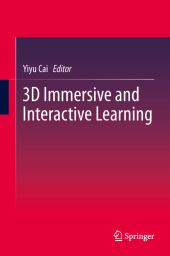 Neuerscheinungen 2015Stand: 2020-02-01 |
Schnellsuche
ISBN/Stichwort/Autor
|
Herderstraße 10
10625 Berlin
Tel.: 030 315 714 16
Fax 030 315 714 14
info@buchspektrum.de |

Yiyu Cai
3D Immersive and Interactive Learning
Herausgegeben von Cai, Yiyu
2013. 2015. vii, 127 S. 57 SW-Abb. 235 mm
Verlag/Jahr: SPRINGER, BERLIN; SPRINGER SINGAPORE; SPRINGER 2015
ISBN: 9814560901 (9814560901)
Neue ISBN: 978-9814560900 (9789814560900)
Preis und Lieferzeit: Bitte klicken
This book reviews innovative uses of 3D for immersive and interactive learning, covering gifted programs, normal stream and special needs education. Reports on curriculum-based 3D learning in classrooms, and co-curriculum-based 3D student research projects.
3D technology is not new; research on 3D started back in early 1960s. But unlike in previous times, 3D technology has now rapidly entered our daily life from cinema to office to home. Using 3D for education is a new yet challenging task. This book will present several innovative efforts using 3D for immersive and interactive learning covering a wide spectrum of education including gifted program, normal (technical) stream, and special needs education. The book will also share experience on curriculum-based 3D learning in classroom setting and co-curriculum-based 3D student research projects.
The book is organized as follows. Chapter 1 introduces the fundamentals of 3D educational technology and their applications in immersive and interactive learning. Chapter 2 discusses the use of virtual reality in teaching and learning of Molecular Biology. Chapter 3 presents the daVinci Lab @ River Valley High School. Chapter 4 describes the 3D education development process. Chapter 5 studies the adaption 3D system for learning gains in lower secondary normal (technical) stream. Chapter 6 investigates the effects of virtual reality technology on spatial visualization skills. Chapter 7 showcases a sabbatical program for students to use 3D for Science, Technology, Engineering and Mathematics (STEM) learning. Chapter 8 shares the use of 3D virtual pink dolphin to assist special education. The foreword of this book is written by Dr Cheah Horn Mun, Director, Education Technology Division, Ministry of Education, Singapore.
1. Introduction to 3D Immersive and Interactive Learning
1.1 Introduction
1.2 Enabling Technologies for In-depth Learning in 3D Immersive and Interactive Learning Environments
1.3 In-depth Learning in Immersive and Interactive Environments
1.4 Conclusion
2. Use of Virtual-Reality in Teaching and Learning Molecular Biology
2.1 Introduction
2.2 The Research Design
2.3 Results and Discussions
2.4 Conclusion
3. Effects of Virtual-Reality Elements on Spatial Visualization Skills of Secondary III Students in Singapore
3.1 Introduction
3.2 Research Design
3.3 Sample
3.4 Treatment - Virtual-reality Elements
3.5 Purdue Spatial Visualization Test
3.6 Conclusion
4. The Project Virtual-Reality Campuses
4.1 Introduction
4.2 Fundamentals of VR Technology
4.3 The Design of VR Campuses Project
4.4 Project Phase 1 - Development of RVHS VR Campuses
4.5 Project Phase 2 - Educational Applications of VR Campuses
4.6 Conclusion
5. Cultivating STEM Education Through 3D Sabbaticals
5.1 Introduction
5.2 The Design of 3D Sabbaticals
5.3 Case Study
5.4 Assessment
5.5 Conclusion
6. A 3D Synergized Discovery and Learning Journey: A Case Study of National Junior College
6.1 Introduction
6.2 The 3D Development and its Successes
6.3 NJC-KSA International Science Exchange Program
6.4 Conclusion
7. 3D System for Learning Gains in the Lower Secondary Normal (Technical) Stream
7.1 Introduction
7.2 Method
7.3 Results and Discussions
7.4 Conclusion
8. Learning Activity System Design for Autistic Children using Virtual Pink Dolphins
8.1 Introduction
8.2 Autism Spectrum Disorder
8.3 Learning Difficulties with Autistic Children
8.4 Learning Activity System Design for Autistic Children using Virtual Pink Dolphins
8.5 VR-enabled Technology using Virtual Pink Dolphins
8.6 Conclusion


